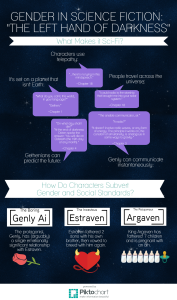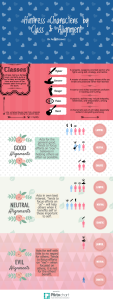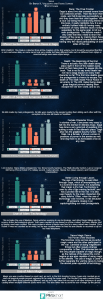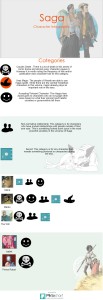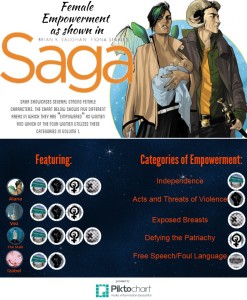Working from an expansive conception of what constitutes science fiction and fantasy literature, this class will explore how these genres have constructed and deconstructed gender identity and sexuality at the intersections of race, class, ethnicity, imperialism, ability, and age. Examining diverse texts, from Octavia Butler’s short story “Bloodchild” to Brian K. Vaughan and Fiona Staples’ comic book series Saga, this class seeks to understand how authors, filmmakers, and artists have mobilized these discourses in creating new worlds and re-imagining our own. Course assignments will use the tools of the digital humanities to create visual definitions of these speculative genres and infographics for comparative analysis of class readings.
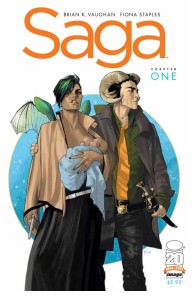 |
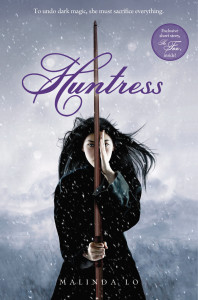 |
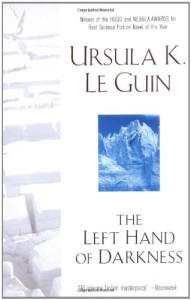 |
Full Schedule of Readings and Assignments
Book List
- Cooper, Karina. Tarnished. Avon, 2012.
- Le Guin, Ursula K. The Left Hand of Darkness. Ace Science Fiction, 2000.
- Lam, Laura. Pantomime. Strange Chemistry, 2013.
- Lo, Malinda. Huntress. Little, Brown Books for Young Readers, 2012.
- Seed, David. Science Fiction: A Very Short Introduction. Oxford University Press, 2011.
- Vaughan, Brian K. Saga. Illus. Fiona Staples. Vol. 1. Image Comics, 2012.
- Wilson, G. Willow. Ms. Marvel Volume 1: No Normal. Illus. Adrian Alphona. Marvel, 2014.
Projects and Assignments
Blog Posts
Each student must post four readings responses (prompts to be distributed throughout the term) to specific reading assignments, three personal reflections on how the course is/is not influencing how they view popular culture, other courses, and (if they choose) their personal lives, and three follow-up responses to others’ responses. While these posts need not be polished pieces of writing, I do expect a certain amount critical thought. The idea here is raise issues about a particular reading or group of readings for the class and start to contextualize those readings in terms of previous class discussions before we discuss the texts in class. Responses will be graded out of ten, with a ten being equivalent to a check for completion. Each post will be no less than 200 words. Links and embedding video are encouraged!
Pinterest Definition Project and Essay
For this assignment, students will create Pinterest boards that visually represent how course texts represent key concepts in science fiction and fantasy’s depictions of gender identity and sexuality, as well as other key categories of identity. Students will write an essay in which they explain the arguments that their boards make, highlighting key pins that they have used to make these arguments.
Here are a few examples of the Pinterest boards created by students in the class:
- Laura Lam’s Pantomime
- Ursula K. Le Guin’s The Left Hand of Darkness
- Malinda Lo’s Huntress
Infographic Comparative Analysis and Essay
Using an online infographic creator, students will create an infographic of a particular text or part of a text. As a class, we will create a list of categories of analysis. Students will then write essays in which they assess what the infographic enables them to explain (and leaves out), why they choose these particular categories for their texts, and how this text compares to other course texts.
Here are a few examples of the infographics created by students in the class:
(click on the image to see a larger version)
- Marlon Edwards’ “Mary Sundown and the Clockmaker’s Children” from Steampunk World
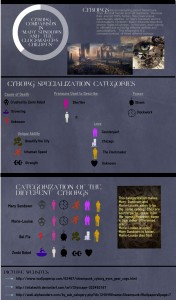
- Laura Lam’s Pantomime
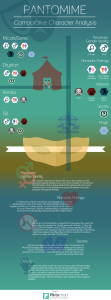

Individual Final Project and Essay
Building on the previous assignments, this final project can take the form of students’ choosing in that they will pick a science fiction or fantasy text (either a class reading or outside text) and a digital artifact. This artifact can be a Pinterest board, infographic, Google Map, or something else of their choosing. After having created the artifact, they will analyze how it addresses issues of class, imperialism, technology, gender identity, sexuality, and other cultural discourses.
Below are few of the course themes that students considered in their projects:
- The ways in which the text plays with conventions of the genres of science fiction and/or fantasy (as well as subgenres like steampunk, fairy tales etc.) in terms of its depictions of gender and/or sexuality
- Breaking down and/or supporting binary oppositions and the hierarchies that are associated with them in our society (self/other, native/alien, white/black, man/woman, white/black, light/dark, heterosexual/any other sexuality, cisgender/transgender, binary sex/intersex)
- The relationship between what this text is doing with gender and/or sexuality and our society’s attitudes towards gender and sexuality — how is the text commenting on our world?
A selection of student projects:
- Karina Cooper’s Tarnished
- G. Willow Wilson and Adrian Alphona’s Ms. Marvel Volume 1: No Normal

